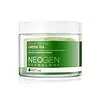What's inside
What's inside
 Key Ingredients
Key Ingredients

 Benefits
Benefits

 Concerns
Concerns

 Ingredients Side-by-side
Ingredients Side-by-side

Water
Skin ConditioningButylene Glycol
HumectantSalicylic Acid
MaskingHydroxypropyl Cyclodextrin
Masking1,2-Hexanediol
Skin ConditioningHydroxyacetophenone
AntioxidantHamamelis Virginiana Water
AstringentNiacinamide
SmoothingDipotassium Glycyrrhizate
HumectantSodium Citrate
BufferingPPG-26-Buteth-26
Skin ConditioningDisodium EDTA
PEG-40 Hydrogenated Castor Oil
EmulsifyingMenthone Glycerin Acetal
RefreshingParfum
MaskingAloe Barbadensis Leaf Water
MaskingHydroxyethylpiperazine Ethane Sulfonic Acid
BufferingWater, Butylene Glycol, Salicylic Acid, Hydroxypropyl Cyclodextrin, 1,2-Hexanediol, Hydroxyacetophenone, Hamamelis Virginiana Water, Niacinamide, Dipotassium Glycyrrhizate, Sodium Citrate, PPG-26-Buteth-26, Disodium EDTA, PEG-40 Hydrogenated Castor Oil, Menthone Glycerin Acetal, Parfum, Aloe Barbadensis Leaf Water, Hydroxyethylpiperazine Ethane Sulfonic Acid
Water
Skin ConditioningDipropylene Glycol
HumectantCamellia Sinensis Leaf Extract
AntimicrobialGlycerin
HumectantAlcohol Denat.
AntimicrobialPEG/PPG-17/6 Copolymer
SolventCentella Asiatica Extract
CleansingArtemisia Vulgaris Extract
Skin ConditioningAloe Barbadensis Leaf Extract
EmollientHouttuynia Cordata Extract
Skin ConditioningGardenia Florida Fruit Extract
Skin ConditioningMelaleuca Alternifolia Leaf Extract
PerfumingCoptis Japonica Extract
AntimicrobialButylene Glycol
HumectantBenzophenone-5
UV AbsorberSodium Hyaluronate
HumectantCarbomer
Emulsion StabilisingTartaric Acid
BufferingGlycolic Acid
BufferingLactic Acid
BufferingTromethamine
BufferingPEG-60 Hydrogenated Castor Oil
EmulsifyingPhenoxyethanol
PreservativeEthylhexylglycerin
Skin Conditioning1,2-Hexanediol
Skin ConditioningMelaleuca Alternifolia Leaf Oil
AntioxidantDisodium EDTA
Parfum
MaskingWater, Dipropylene Glycol, Camellia Sinensis Leaf Extract, Glycerin, Alcohol Denat., PEG/PPG-17/6 Copolymer, Centella Asiatica Extract, Artemisia Vulgaris Extract, Aloe Barbadensis Leaf Extract, Houttuynia Cordata Extract, Gardenia Florida Fruit Extract, Melaleuca Alternifolia Leaf Extract, Coptis Japonica Extract, Butylene Glycol, Benzophenone-5, Sodium Hyaluronate, Carbomer, Tartaric Acid, Glycolic Acid, Lactic Acid, Tromethamine, PEG-60 Hydrogenated Castor Oil, Phenoxyethanol, Ethylhexylglycerin, 1,2-Hexanediol, Melaleuca Alternifolia Leaf Oil, Disodium EDTA, Parfum
Ingredients Explained
These ingredients are found in both products.
Ingredients higher up in an ingredient list are typically present in a larger amount.
1,2-Hexanediol is a synthetic liquid and another multi-functional powerhouse.
It is a:
- Humectant, drawing moisture into the skin
- Emollient, helping to soften skin
- Solvent, dispersing and stabilizing formulas
- Preservative booster, enhancing the antimicrobial activity of other preservatives
Butylene Glycol (or BG) is used within cosmetic products for a few different reasons:
Overall, Butylene Glycol is a safe and well-rounded ingredient that works well with other ingredients.
Though this ingredient works well with most skin types, some people with sensitive skin may experience a reaction such as allergic rashes, closed comedones, or itchiness.
Learn more about Butylene GlycolDisodium EDTA plays a role in making products more stable by aiding other preservatives.
It is a chelating agent, meaning it neutralizes metal ions that may be found in a product.
Disodium EDTA is a salt of edetic acid and is found to be safe in cosmetic ingredients.
Learn more about Disodium EDTAParfum is a catch-all term for an ingredient or more that is used to give a scent to products.
Also called "fragrance", this ingredient can be a blend of hundreds of chemicals or plant oils. This means every product with "fragrance" or "parfum" in the ingredients list is a different mixture.
For instance, Habanolide is a proprietary trade name for a specific aroma chemical. When used as a fragrance ingredient in cosmetics, most aroma chemicals fall under the broad labeling category of “FRAGRANCE” or “PARFUM” according to EU and US regulations.
The term 'parfum' or 'fragrance' is not regulated in many countries. In many cases, it is up to the brand to define this term.
For instance, many brands choose to label themselves as "fragrance-free" because they are not using synthetic fragrances. However, their products may still contain ingredients such as essential oils that are considered a fragrance by INCI standards.
One example is Calendula flower extract. Calendula is an essential oil that still imparts a scent or 'fragrance'.
Depending on the blend, the ingredients in the mixture can cause allergies and sensitivities on the skin. Some ingredients that are known EU allergens include linalool and citronellol.
Parfum can also be used to mask or cover an unpleasant scent.
The bottom line is: not all fragrances/parfum/ingredients are created equally. If you are worried about fragrances, we recommend taking a closer look at an ingredient. And of course, we always recommend speaking with a professional.
Learn more about ParfumWater. It's the most common cosmetic ingredient of all. You'll usually see it at the top of ingredient lists, meaning that it makes up the largest part of the product.
So why is it so popular? Water most often acts as a solvent - this means that it helps dissolve other ingredients into the formulation.
You'll also recognize water as that liquid we all need to stay alive. If you see this, drink a glass of water. Stay hydrated!
Learn more about Water